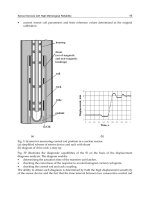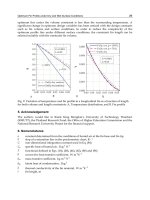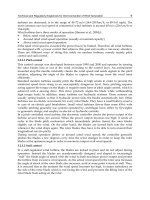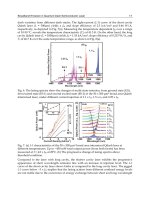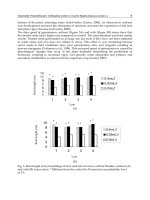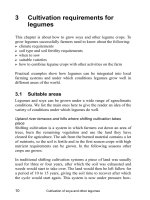Blood and Blood Transfusion - part 2 pot
Bạn đang xem bản rút gọn của tài liệu. Xem và tải ngay bản đầy đủ của tài liệu tại đây (77.66 KB, 11 trang )
1
1: Transfusion requirements in
critical care
MARTIN G TWEEDDALE
On behalf of the Canadian Critical Care Trials Group and the Transfusion Requirements in
Critical Care Investigators (PC Hebert, Principal Investigator, MA Blajchman, J Marshall,
C Martin, G Pagliarello, I Schweitzer, MG Tweeddale and G Wells)
Introduction
The art of fluid administration and haemodynamic support is one of
the most challenging aspects of current critical care practice. Although
more than half the patients in intensive care units (ICU) receive blood
transfusions there is little in the way of data to guide decisions on when
to give transfusions. The American College of Physicians, among others,
has published a transfusion algorithm.
1
However, this is based, not on
controlled clinical trials, but on expert opinion. Despite these guidelines,
transfusion practice varies widely. Estimates of the frequency of
inappropriate transfusion range from 4–66% in the literature.
2
This article
describes a multi-centre randomised controlled trial of a liberal versus a
restrictive transfusion protocol in ICUs in Canada.
3
The trial was
sponsored by the Canadian Critical Care Trials Group (an informal
association of people interested in promoting critical care research) and
was funded by the Canadian Medical Research Council and Bayer plc.
To transfuse or not to transfuse?
Prior to undertaking a clinical trial it is important to consider the
arguments for and against treatment. Box 1.1 shows some reasons that
doctors might give as to why stable patients in ICU should be transfused.
In fact, transfusion practice is a good example of how some patterns of
treatment in critical care have been set prematurely without proper clinical
or experimental evidence. The first four possibilities listed in Box 1.1 are
each plausible, but none is proven or definitive. For example, it has been
theorised that improving oxygen delivery and reducing oxygen debt would
improve survival.
4
This has led to the assumption that transfusing patients
on ICU is beneficial, with common practice dictating maintenance of
haemoglobin concentrations at 100 or 120g/l, despite some evidence of
a detrimental effect of this practice.
5
Unfortunately, in Canadian critical
2
care units, less than 50% of blood transfusions are given for physiological
reasons such as haemodynamic instability or active bleeding.
6
In effect, the
majority of transfusions are given simply to achieve a specific laboratory
value, and no specific change in physiological parameters is produced by
the transfusion. This is confirmed by a recent study of blood transfusion
practice in the London area.
7
This survey showed that 74% of the
transfusions were given for “a low haemoglobin”. In this survey the mean
transfusion threshold was 88 g/l, but 25–30% of the transfusions were given
at haemoglobin values above 90 g/l.
If there are arguments for transfusion there are also arguments against.
In Box 1.2, the first three statements are simply refutations of points made
in Box 1.1 and like the latter, are plausible, but not properly substantiated.
The first item in Box 1.2 illustrates a point which is often forgotten:
physiological regulation is very effective, both in adapting to disease (such
CRITICAL CARE FOCUS: BLOOD AND BLOOD TRANSFUSION
Box 1.1 Reasons for transfusing stable critically
ill patients
• Augmenting oxygen delivery may improve outcome
• To decrease the risk of coronary ischaemia in coronary artery
disease
• Age, disease severity and drugs may interfere with the normal
adaptive response to anaemia
• To improve the “safety margin” in the event of further blood loss
• To achieve a specific laboratory value
Box 1.2 Reasons for not transfusing stable critically
ill patients
• Red cell transfusions may not affect oxygen delivery
• Pathological supply dependency is rare
• No evidence that a higher haemoglobin concentration is of value
in coronary artery disease
• Transfusion may impair microcirculation
• Transfusion may cause immunosuppression and increase
infection rates
• The risks of transfusion may outweigh the benefits
3
as critical care anaemia) and in adapting to treatment (such as blood
transfusion). For example, an increase in haemoglobin will almost certainly
increase the oxygen carrying capacity of the blood. However, this may not
necessarily increase oxygen delivery (unless this parameter is already
inadequate). Rather, it is probable that cardiac output will fall to maintain
the same oxygen delivery, but at a reduced level of cardiac work. In such a
scenario, blood transfusion will not achieve the theoretical objective for
which it was given.
The final three points in Box 1.2 do, however, raise substantive
issues against unnecessary blood transfusion in critically ill patients.
The penultimate point, in particular, is often ignored – among current
critical care text books, only one mentions the possibility of immune
consequences from blood transfusion, an issue addressed later in this
volume (Chapter 2). It is indeed arguable that the risks of transfusion may
outweigh the benefits.
Clinical trial
Existing practice before the trial
Before undertaking our trial of transfusion strategies, we surveyed more
than 5000 patients admitted to six tertiary level ICUs in Canada, and
found that 25% of patients received transfusions of red blood cells during
the survey period.
6
Practice varied considerably, however, between ICUs,
even after adjustment for patient age, acute physiological and chronic
health evaluation (APACHE) II score, and diagnostic category. The most
frequent reasons given for transfusing red blood cells were acute bleeding
(35%) and augmentation of oxygen delivery (25%).The transfused patients
received an average of 0·95 units per patient day. Given that 1650 patients
were transfused, and that the average stay in ICU was approximately five
days, this represents a very large amount of blood. Most (80%) of the
transfusion orders were for two units, even though published guidelines
suggest that only one unit should be transfused at a time. Figure 1.1 shows
the mean transfusion thresholds for patients with low APACHE II scores
(15 or below) in each of the six ICUs that were involved in the study.
6
The transfusion threshold haemoglobin concentration varied from
79–95 g/l. In the UK the threshold haemoglobin level is similar to the mean
value in the Canadian study, around 85–86 g/l, although the range goes
from 78 g/l haemoglobin up to 95 g/l haemoglobin.
7
In another study, four
specified scenarios were used as part of a national survey of Canadian
critical care physicians.
8
Figure 1.2 shows that in the “trauma” scenario
more than 50% of Canadian physicians would have accepted a
haemoglobin of 85 g/l or less in their patient, but in a physiologically similar
patient with active gastrointestinal bleeding, 50% of the physicians wanted
TRANSFUSION REQUIREMENTS IN CRITICAL CARE
4
to see a haemoglobin level of at least 100 g/l.This survey shows the marked
differences in the approach of critical care doctors to transfusion in
different clinical scenarios.This survey also found that Ͼ90% of Canadian
critical care doctors would transfuse multiple units of red cells, despite
guidelines to the contrary. Generally, practice varied widely between
centres, physicians themselves, and patient groups.
6,8
CRITICAL CARE FOCUS: BLOOD AND BLOOD TRANSFUSION
100
95
90
85
80
75
70
Haemoglobin (g/l)
123456
Institution number
Figure 1.1 Mean transfusion thresholds by institution number in patients with APACHE II scores
of 15 or less. Drawn, with permission, from data presented in Hebert PC, et al. Crit Care Med
1999;3:57–63.
6
50
45
40
35
30
25
20
15
10
5
0
Frequency (%)
<65 65–75 75–85 85–95 95–105 >105
Haemoglobin (g/I)
Trauma
Gl Bleed
Figure 1.2 Transfusion thresholds in trauma and gastrointestinal bleed scenarios as identified by
Canadian critical care physicians in a survey questionnaire. Drawn, with permission, from data
presented in Hebert PC, et al. Crit Care Med 1999;3:57–63.
6
5
These studies
6,8
clearly showed that a state of “clinical equipoise” existed
in the practice of transfusion in ICU, and that a randomised controlled
trial was therefore warranted. The trial was titled “Transfusion
Requirements in Critical Care” (TRICC). It was run from Ottawa with
Paul Hebert as principal investigator, and an executive committee who
reported regularly to the Canadian Critical Care Trials Group. The TRICC
trial compared a restricted versus a liberal red cell transfusion strategy in
terms of mortality and morbidity in adequately resuscitated critically ill
patients.
3
Study design
The study was randomised but could not be blinded. It was set up as an
equivalency trial, powered to detect a 5% absolute difference in the
primary end point (30-day all-cause mortality). Both type I and type II
errors were set at 5%, and it was determined that 1620 patients were
required. Twenty-five Canadian ICUs, 22 in University centres and 3
community ICUs, were involved in the study and, most importantly, the
sub group analyses (APACHE II score above or below 20, and age above
or below 55) were defined at the outset.
Any patient admitted to the ICU whose haemoglobin fell to 90 g/l or less
within 72 hours was potentially eligible. Patients had to be adequately
volume resuscitated, according to the discretion of the physicians, and the
patients had to have a predicted length of ICU stay of at least another 24
hours. Obviously consent was also required. Exclusion criteria included
pregnancy, age less than 16 years, and an inability to receive blood
products. Patients who were actively bleeding (defined as a 30 g/l decrease
in haemoglobin concentration or more than 3 units transfused over the
preceding 12 hours) and patients with chronic anaemia (haemoglobin
Ͻ90 g/l for more than 1 month previously) were also excluded. In
addition, those with a hopeless prognosis or who were admitted for routine
post-operative care after cardiac surgery were also excluded.
Study interventions
In patients randomised to the restrictive strategy, haemoglobin levels
were maintained at 70–90 g/l with a transfusion trigger of 70 g/l. Those
randomised to the liberal strategy had their haemoglobin concentrations
maintained at 100–120 g/l, with a transfusion trigger of 100 g/l. The
strategies were adhered to throughout the ICU stay but it was impractical
to follow up beyond that. Patients received transfusions one unit at a time,
with a subsequent check of the haemoglobin value. Other aspects of care
were not controlled, but co-interventions were carefully monitored.
TRANSFUSION REQUIREMENTS IN CRITICAL CARE
6
Results
Recruitment
A total of 6451 patients met the basic inclusion criterion, but only 838
were actually enrolled. This study therefore achieved only 52% of its target
recruitment and was thus underpowered. The reasons why patients were
missed or excluded are shown in Figure 1.3.
The TRICC trial suffered an unexpectedly high refusal rate (68%). The
usual rate in Canada is about 45–50%. It was particularly concerning that
about half the refusals were by the attending physicians rather than the
patients or their relatives. This could potentially introduce bias into the
CRITICAL CARE FOCUS: BLOOD AND BLOOD TRANSFUSION
6451
Assessed
Chronic anaemia (n = 800)
Active blood loss (n = 786)
Anticipated length of stay,
<24 hr (n = 818)
Enrolment in other studies
(n = 423)
Moribund (n =162)
DNR order (n = 133)
Other reasons (n = 123)
3245 Excluded
1167 Not screened
Previous transfusion
(n = 297)
Time limitations (n = 256)
No next of kin (n =174)
Language barrier (n = 36)
Other reasons (n = 404)
1201 Refused
Physician refusal (n = 598)
Patient or family refusal
(n = 603)
2039
Screened for consent
3206
Found eligible
838
Consented
420
Assigned to liberal
transfusion strategy
418
Assigned to restrictive
transfusion strategy
4
Withdrew
5
Withdrew
Figure 1.3 Numbers of patients assessed and enrolled in the trial. DNR denotes do not resuscitate.
Previous transfusion indicates receipt of transfusion that increased the haemoglobin concentration to
more than 90 g/l. Reproduced with permission from Hebert PC, et al. N Engl J Med 1999;340:
409–17.
3
7
study, since the enrolled patients would not constitute a truly representative
sample. However, in my own institution, the reasons why doctors refused
consent for their patients were two-fold: half of them wanted their patients
to receive blood and half of them did not. Clinical equipoise was thus
eloquently demonstrated! Many family refusals were related to an
unfortunate issue of timing. The study was run during a high profile
national enquiry into administration of tainted blood involving threatened
lawsuits and a great deal of media attention. Every time public awareness
of the enquiry rose, recruitment went down, at least in this author’s unit.
In the end 420 patients were randomised to the liberal strategy group
and 418 to the restrictive strategy group. Fortunately there were very few
withdrawals (see Figure 1.3).
Demographic data
The two groups were very well matched in terms of gender, age, APACHE
II score and multiple organ dysfunction score at entry (Table 1.1). In terms
of the ICU interventions patients were receiving on study entry, again
the groups were also very well matched (Table 1.1). Pre-randomisation
haemoglobin values, total fluid intake, the number of transfusions before
TRANSFUSION REQUIREMENTS IN CRITICAL CARE
Table 1.1 Baseline characteristics of the two patient groups.
Patient characteristics Liberal strategy group Restrictive strategy group
N ϭ420 Nϭ 418
Males (number) 255 (61%) 269 (64%)
Age (years) 58·157·0
APACHE II score 21·320·9
MODS 7·67·4
Mechanical ventilation 346 (83%) 340 (82%)
(number)
Vascular catheter (number) 399 (95%) 393 (95%)
Pulmonary artery catheter 150 (36%) 141 (34%)
(number)
Vasoactive drugs (number) 154 (37%) 153 (37%)
Patients on dialysis (number) 18 (4%) 21 (5%)
Surgical interventions 17 (4%) 16 (4%)
(number)
Haemoglobin (g/dl) 8·2 Ϯ 0·78·2 Ϯ 0·7
Total fluid intake (l) 3·99 Ϯ 1·71 3·95 Ϯ 2·21
Tranfusions (units) 2·3 Ϯ 4·62·5 Ϯ 6·5
Lactate (mmol/l) 1·8 Ϯ 2·11·8 Ϯ 1·8
Data reproduced with permission from Hebert PC, et al. N Engl J Med
1999;340:409–17.
3
8
enrolment and lactate concentrations were essentially identical in the two
groups (Table 1.1).
Study intervention data
The mean haemoglobin concentrations after intervention were 107 g/l in
the liberal strategy group and 85 g/l in the restrictive strategy group
(pϽ 0·01). The number of units of blood transfused per patient was 5·2
units for the liberal group, and 2·5 units in the restricted group, a reduction
of 54%. By protocol, all patients in the liberal group, and 33% of the
restrictive group received no blood during their ICU stay. Compliance with
the protocol was excellent (93% in the liberal group and 98% in the
restrictive group) and there were very few crossovers (2·6% in the liberal
group and 1% in the restrictive group).
Figure 1.4 shows haemoglobin values plotted against time. In the
restrictive group a relatively steady value with a constant error was seen. In
the liberal strategy group values decreased slightly over time and the error
bars became wider. However the haemoglobin values were statistically
significantly different at all time points between the two groups.
All cause 30-day mortality was 23·3% (98 patients died) in the liberal
strategy group and 18·7% (78 patients died) in the restrictive strategy
group – an absolute difference of 5%. However, due to low recruitment
to the study, this difference failed to reach significance (pϭ0·11). There
were no significant differences between the groups in ICU stay or organ
dysfunction scores. Thus, at the very least, the TRICC trial shows that
CRITICAL CARE FOCUS: BLOOD AND BLOOD TRANSFUSION
130
120
110
100
90
80
70
60
Haemoglobin (g/l)
0 5 10 15 20 25 30
Restrictive group
Time (days)
Liberal group
Figure 1.4 Haemoglobin concentration against days after admission to the intensive care unit in the
restrictive strategy and liberal strategy groups in TRICC patients. Data are median and 95%
confidence intervals. Drawn, with permission, from data presented in Hebert PC, et al. N Engl J
Med 1999;340:409–17.
3
9
there is no clinical advantage in transfusing resuscitated ICU patients to
haemoglobin values above 70–90 g/l. Furthermore, such a restrictive
transfusion policy is associated with a considerable reduction in the
amount of blood used.
While the overall results failed to show a significant difference between
the two transfusion strategies, the pre-determined sub-group analyses were
very revealing. In the patients with an APACHE II score Ͻ20, 30-day all-
cause mortality was 8·7% in the conservative strategy patients, compared
to 16·1% in the liberal strategy patients (pϭ0·02). In the patients with
APACHE II scores of Ͼ20, there was no difference in mortality (31% in
the liberal group and 28·3% in the restrictive group). Similarly, in younger
patients (but not in those over 55 years of age) there was a statistically
significant mortality difference that favoured the restricted strategy. Figure 1.5
TRANSFUSION REQUIREMENTS IN CRITICAL CARE
Patients with APACHE II Score <20
Restrictive-
transfusion
strategy
Liberal-
transfusion
strategy
P=0
.
02
Days
Survival (%)
100
90
80
70
60
50
0 5 10 15 20 25
30
Patients Younger than 55 Years
Restrictive-
transfusion
strategy
Liberal-
transfusion
strategy
P=0
.
02
Days
Survival (%)
100
90
80
70
60
50
0 5 10 15 20 25
30
A
B
Figure 1.5 Kaplan-Meier estimates of survival in patients: A. with APACHE II scores below 20
and B. aged below 55 years. Reproduced with permission from Hebert PC, et al. N Engl J Med
1999;340:409–17.
3
10
shows the Kaplan-Meier survival curves for the patients sub-grouped
according to APACHE II score or age. It can be seen that the significant
mortality advantage of the restrictive transfusion strategy in patients with
APACHE II scores below 20, or aged below 55 years, is apparent
immediately and is held throughout the study period.We can conclude that
unnecessary transfusions in younger, less sick patients in ICU are actually
harmful.
Complications
Cardiac complications were more common in the liberal strategy group
(21% versus 13%, pϽ 0·01). There were differences in the number of new
infarctions (12 versus 3 cases; pϽ0·02) and pulmonary oedema (45 versus
22 cases; pϽ0·01). Acute respiratory distress syndrome showed a tendency
to occur more frequently in the liberal strategy group than in the restrictive
strategy group (48 versus 32 cases; pϭ0·06).
Summary
The TRICC trial, although limited by recruitment difficulties, was well-run
with Ͼ93% compliance with the protocol, and few crossovers. Within the
restrictive group, red blood cell transfusion use was reduced by 54% and a
third of the patients randomised to this group were not transfused at all
during their ICU stay. With an average cost of £72 per unit in the UK,
introduction of the TRICC restrictive transfusion strategy would result in
very substantial savings in blood costs. Similarly, the TRICC strategy has
advantages of cost, practicality and outcome compared with the use of
erythropoietin, which has been proposed to combat anaemia in the
critically ill.
9
Although the trial lacked sufficient power to demonstrate a
significant difference in outcome between the two strategies, in the sub-
group analysis the restrictive strategy was significantly more effective in
terms of mortality in younger and less ill patients.
Conclusion
The TRICC trial has added to the literature showing harmful effects of
blood transfusion. Why might this be so? The blood given in the liberal
transfusion strategy may be harmful perhaps because of immune
suppression (see Chapter 2). Alternatively, it might be that tissue oxygen
delivery was actually decreased. Much of the blood administered during
the TRICC trial would be old (Ͼ16days) due to the working of the
Canadian Blood Transfusion Service.The age of blood may have significant
effects on clinical outcome.
10
Since old blood is non-deformable, it can
clog capillaries, and this may be particularly relevant in septic patients who
CRITICAL CARE FOCUS: BLOOD AND BLOOD TRANSFUSION
11
already have microvascular abnormalities.Thus tissue oxygen delivery may
be actually decreased even though haemoglobin is increased.
11
The
presence and non-reversibility of storage lesions in old blood is well known
and may have contributed to the adverse consequences documented in the
TRICC trial. On the other hand, the beneficial effects of the restrictive
strategy may arise from haemodilution, reducing blood viscosity and so
promoting oxygen delivery and improving flow in the microcirculation.
These points reiterate that we know very little about this product which we
give so freely to our critically ill patients.
No study is perfect and this one was no exception. The study was
underpowered due to high refusal rates from physicians and relatives.Whilst
it is possible that this may have introduced bias in the selection of patients
for the study, there is no evidence to support this. The patients enrolled do
seem to represent a broad range of typical ICU patients and therefore the
trial results should be generally applicable, including patients admitted to
critical care units with various primary or secondary cardiovascular
diagnoses.
12
The one exception which should be noted is that patients with
acute coronary syndromes were very uncommon in our study population
because in Canada (as in the UK), most of these patients are admitted
to cardiac care units rather than ICU. It therefore remains possible that the
TRICC trial results would not be applicable to this patient group.
Leucocyte depleted blood is now available in the UK and in Canada and
its use might ameliorate the harmful effects of the liberal strategy. But one
should ask why blood should be given at £72 per unit when no clinical
benefit would be expected? The TRICC trial clearly shows that stable
resuscitated critically ill patients do very well if they are maintained with
haemoglobin values of 70–90 g/l.
There are two recommendations which are applicable in the light of this
study. In stable, resuscitated, critically ill patients, a transfusion strategy
comprising a threshold of 70 g/l, with haemoglobin values maintained
between 70–90 g/l should normally be used. This regime is both safe and
cost-effective. Secondly, further research into blood product transfusion in
ICU patients should be a priority for the critical care community.
References
1 American College of Physicians. Practice strategies for elective red blood cell
transfusion. Ann Intern Med 1992;116:403–6.
2 Hebert PC, Schweitzer I, Calder L, Blajchman M, Giulivi A. Review of the
clinical practice literature on allogeneic red blood cell transfusion. Can Med
Assoc J 1997;156:S9–S26.
3 Hebert PC, Wells G, Blajchman MA, et al. A multicenter, randomized,
controlled clinical trial of transfusion requirements in critical care. Transfusion
Requirements in Critical Care Investigators, Canadian Critical Care Trials
Group. N Engl J Med 1999;340:409–17.
TRANSFUSION REQUIREMENTS IN CRITICAL CARE

